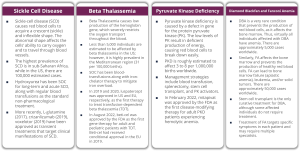Challenges in Hemoglobinopathies Projects and the Support of KOL Match
There are over 7,000 rare diseases described, affecting about 20-30 million people in the U.S. alone, according to the NIH. While each condition has its specificities, there are common challenges in the rare disease space, such as finding patients and leveraging centers of excellence and referral networks. This article discusses such challenges and how partnering with SAI’s subject matter experts can help overcome them.
Hemoglobinopathies are a family of rare diseases characterized by a defect in hemoglobin, the protein inside red blood cells that carries and delivers oxygen throughout the body. Although it is difficult to precisely determine the number of individuals affected by hemoglobinopathies, it is estimated that between 300,000 and 400,000 newborns every year have hemoglobin disorders.
While transient treatments have been the standard of care for most hemoglobinopathies, recently, gene therapy has strongly emerged as a potential curative treatment. In August 2022, the gene therapy beti-cel (Zynteglo, bluebird bio) has been approved by the FDA to treat adult and pediatric patients with transfusion-dependent beta-thalassemia. In addition, gene editing approaches (e.g., CRISPR/Cas) are invading the hematological space and can change the paradigm of disease therapeutics.
Despite the common defining characteristic of hemoglobinopathies, each condition has a unique underlying cause (i.e., specific genetic alterations). Thus, each condition affects unique populations and is supported by specialized healthcare professionals. Such differences, as well as the treatment methodology (curative vs. transient), determine the choice of specialists and patient population involved in a clinical study.
Our rare disease experts thoroughly understand the geographic distribution of hemoglobinopathies and the challenges associated with finding specialized centers and experts worldwide. At SAI, we utilize a curated list of top KOLs to find the best specialists driving innovation and treatment paradigms in hemoglobinopathies and other rare diseases.
KOL Match Rare Disease is SAI MedPartners’ subscription-based tool, which blends our extensive network of KOLs to our long-standing commitment to advancing rare disease research and development. This vetted KOL database supports our clients’ initiatives such as advisory board construction and clinical trial site selection, and it informs KOL interactions and engagement strategy.
The unique challenges in the hemoglobinopathies space require rigorous, expert work such as our rare disease experts do every day, with the support of unique tools such as our KOL Match database. Whether you want to discuss our strategic consulting capabilities in the rare disease space or explore the breadth of KOL Match, please contact us today.
Sources:
Kavanagh PL, Fasipe TA, Wun T. Sickle Cell Disease: A Review. JAMA. 2022 Jul 5;328(1):57-68. doi: 10.1001/jama.2022.10233. PMID: 35788790.
Gil Bellis, Alain Parant. Beta-thalassemia in Mediterranean countries. Findings and outlook. Investigaciones Geográficas, Instituto Universitario de Geografía. Universidad de Alicante (Spain), 2021, pp.1-10. ff10.14198/INGEO.19079ff. ffhal-03447028f
Grace RF, Barcellini W. Management of pyruvate kinase deficiency in children and adults. Blood. 2020 Sep 10;136(11):1241-1249. doi: 10.1182/blood.2019000945. PMID: 32702739.
https://rarediseases.info.nih.gov/
Similar posts:
In the healthcare regulation sphere, proposed EU-level joint clinical assessments (JCAs) have sparked debate in the pharmaceutical industry. A recent EFPIA report highlights concerns about the rigidity of the guidelines, particularly in oncology, and suggests revisions to ensure a more efficient and adaptable evaluation process that accommodates diverse stakeholder needs across Europe. In the realm […]
A Comprehensive Exploration of Competitive Intelligence, Knowledge-Sharing, and Strategic Optimization in the Evolving Landscape of EU Health Technology Assessments. The first companies undergoing the JCA process in 2025 will indeed be pioneers, blazing a trail for others to follow. These early adopters will be the first to gain practical experience with the JCA, providing valuable […]
What rare disease day means for our work at SAI Every leap year, on the 29th of February, the world pauses to acknowledge Rare Disease Day—a beacon of solidarity for the millions navigating the labyrinth of rare and often isolating medical conditions. It’s a day that transcends boundaries, echoing the voices of patients, caregivers, and […]


